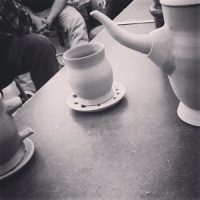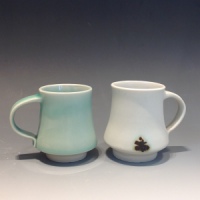Last week, my Ceramics I students set up their first bisqued mugs all over our studio tables for our second attempt at critique. The first round, after they created simple pinch pots, was barely even a discussion of the work. We talked about skills, and I asked them to describe the challenges and satisfactions of the process. This time, we were ready to talk about actual objects.
Mixed in with the Ceramics I students’ work, I placed a dozen or so of my advanced students’ mugs. I invited the students to just spend a few minutes browsing the cups.
“There’s no way that someone in Ceramics I made this one,” observed Ian as he handled a delicate teacup with a graceful handle. “Yeah, but one of you made this one, and it’s amazing,” I countered, holding a lopsided cup that felt just about perfect in my hand. Nods of agreement followed as I passed that cup to the students around me. Its handle was crooked, but it fit our hands gracefully.
Actual critique process? Select one mug you are drawn to; sketch it; write three bullet points about why. Select one mug you would never use; sketch it; write three bullet points why. Then select your favorite of the ones you’ve made. Sketch it, and with the same objectivity you used to assess your peers’ work, write three bullet strengths and three bullet challenges or areas for improvement. Share. Repeat.
The cup I was drawn to was an object made by one of my upperclassman students. On first glance, it is nearly a technically perfect mug. Light as a feather, graceful rim, voluminous body, articulate foot. Look a little closer, and you notice that he deliberately cut a hole in the bottom of the cup and sliced its handle in half, effectively rendering it useless. I know his story and thinking behind these decisions, his intentions and purpose. It’s a lovely, sad story that is his to tell. Yet through choosing Joe’s piece, I was caught off-guard by a realization about the cup and about myself.
For me, yes, the handmade cup is an object – but it’s not about the cup. It is not an object that is defined by its function or form. It is a representation of the creator’s time, attention, process, and creativity. It is a snapshot both of a community process – from recycled clay to collaborative space to shared kiln – and of an individual’s skill development and intention. And you get to hold all of that in your hand, bring it to your lips, consider what it means. What a crazy, complex thing.
And how many crazy, complex things we overlook. Because then, still speechless for a moment in front of my class, I was thinking about how often what we create might not really be about what we create.
Take – for instance – social media. Late last year, I was the target of a mild series of negative tweets, shared by a few students who probably didn’t fully consider that their posts were public. The tweets themselves were not the object of my sadness or frustration. It was the representation of my students’ time and intentions – a snapshot of the derision I actually thought they felt towards me. The incident haunted me, in both context and representation. Still does. It was a snapshot of how so many of the teenagers with whom I work live their daily lives – anticipating the next ‘like’ or ‘RT’ or comment that defines self. I felt what I think many of them feel – and it hurt. Although I’ve moved forward and discussed things directly with the students involved, what they created had implications. It could be discussed and forgiven, but it could not be taken back.
Or take that hasty email that I sent in response to a colleague at the end of the last day before break. As soon as I clicked send, I knew that I had not chosen my words carefully enough, that my response reflected more about my exhaustion than its desired intention. The email itself was not the object; it was just a quick note with a few misspellings. But I knew that how it would be perceived would represent a dismissive approach that I did not intend. It was a snapshot that did not depict anything of value. And I just put it in out into the world, carelessly. Like a bisqued cup, it could no longer be recycled or restated.
Of course, my Ceramics I students’ cups may not yet have any deep sense of intention. They are still learning the mechanics of a handle and foot. But whether or not the object carries intentional representation, it does stand for something. As I explained to my students, once something has been bisqued, it will be in the world for thousands of years. They have added to our cosmic dump, for better or for worse. Hopefully for better.
Adding to the world – creating – whether it is a cup or a tweet or a personal connection – carries implication. It does so whether we intend that implication or not, and for better or for worse. It’s taking charge of those implications that constitutes the lifelong journey I’m starting to define as art.
So I stood there in front of my students, mute for a moment, peering at some of them through the hole in the bottom of Joe’s cup. One or two of them giggled at the long pause.
Blinking, I shook it off, suddenly aware that I was creating a silence that had its own implications. Onward with the critique, onward with the day, onward with the year, onward with just a little more intention. And grateful for the opportunity to think through and share more than just cups with those who are entrusted to create.









I love your thoughts on this! Glad I discovered your blog this morning 🙂
One of the first things that impressed me when I first touched clay in my very first class was that even with that tentative nudge in the shape of a lump something in the world was now different. I had changed the world, and this was somehow more obvious to me than all the difference that mu normal daily activities make. And so it seemed to me that we are in fact all artists in some sense, whether we realize it or not, and that even the small actions we perform alter the course of events and set the world on its new path. And recognizing this it became clear that in reinventing the world through these creative/generative acts carried with it a moral responsibility. In other words, what we do has an inherent potential for moral implication. We are actively deciding the fate of the material world, at the very least.
In my first attempts at teaching I was confronted with the serial opinion that most folks simply don’t think of themselves in creative terms. They might never think of themselves as ‘artists’ even having taken a few courses of art. There was a gap in the thinking most students had between doing something and the consequences of that doing. The idea of responsibility seemed so foreign to most of them in this context. And so I tried to make the point in those early days that just being in a relationship creates something the world has never before seen: You and this other person coming together to make something new, a unity where before there had been separateness. Cooking a meal, growing a garden, telling a story, all these things have implications for how at least some small portion of the world will turn out. And if you can make that difference, how is it not an issue of responsibility?
Or so it seems to me….
Thanks again for sharing! I look forward to reading your other posts!